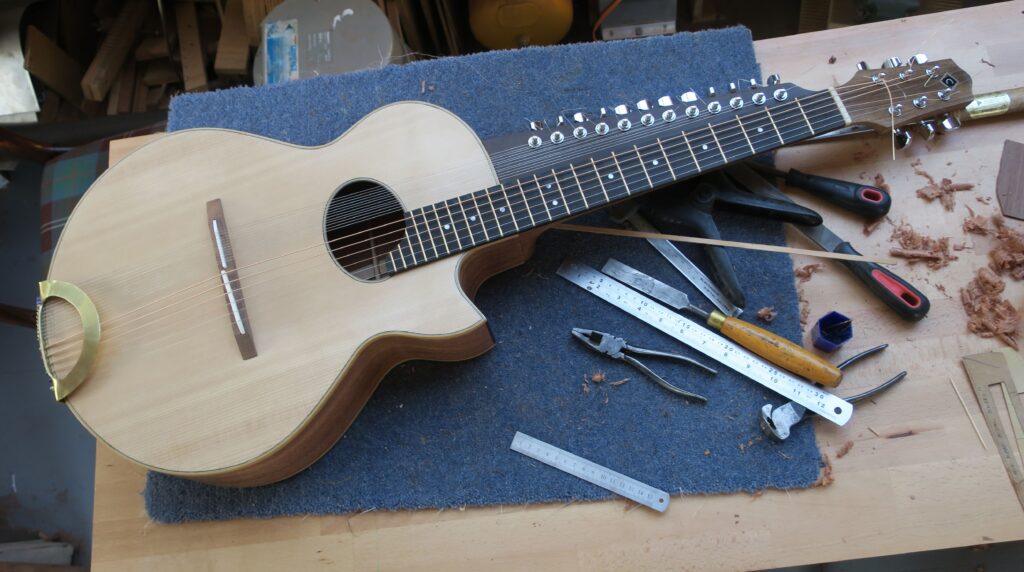(in fact it’s a sympitar …)

When I was a teenager in Edinburgh the top act on the folk scene was the Corries. They went on to major success as a duet and to write unofficial national anthem “Flower of Scotland”. (A bit militaristic for my taste but that’s something else) One of the Corries, Roy Williamson, built them a pair of instruments, the combolins. One combined a mandolin and a guitar along with four bass strings tunable with slides, the other combined guitar, a set of sympathetic strings and a bandurria, the latter being an instrument Williamson had played since the early days of the Corrie Folk Trio. Roy has passed on, there’s not a lot of information about the Combolins and as far as I know they haven’t been seen or heard for many years.
So … a while ago Ted Brown asked if I could make one. Long pause, much sucking of teeth and a bit of “Are you kidding?”. Long discussion. With very little information to go on we decided not to even try to stick to the original design, to skip the mandolin / bandurria neck, to go with sympathetic strings and otherwise keep it as simple as possible. (That last bit may have been a joke) Finally on the original it sounds as if the bass strings have a sitar style Jawari buzz bridge and this was the sound that was wanted. The result is essentially a sympitar, a guitar sitar hybrid. I’ve built this instrument with a floating bridge and tailpiece, partly so we can play with different configurations. The present bridge is temporary while I get the rest of the instrument set up.
To be continued …
Here are the Corries and the Combolins

Can’t wait to hear the final result! If you were considering making another, I would love to talk about being a customer. I have been wanting something like this for years.
I’d love to make another! I have a very rough video recording I made before it left home – I’ll email you as soon as I can find it.
Hi there im from Edinburgh looking to recreate the same instrument, if you have any advice I’m all ears
Hi Cameron, there was a long conversation before we got to this design, notably ditching the mandolin / bandurria bit. I’ll send you an email so we can have a conversation, I can tell you what I did and what I’d change next time. Good luck – it’s quite a project!
Hi Ian, is there an email I can reach out to you to talk about building work?
Hi Richard, email is on the contact page. Look forward to hearing from you.
Okay I’ve got it, I’ll write to you soon.
‘Both Roy and Ronnie have passed on.’ Don’t know where you got your information from, but Ronnie Browne is still very much alive.
Ooops, that’s a bad mistake. Don’t know where I picked that up. I’ll correct it right now. And maybe he knows where the combolins are!
I am curious how you attached the sympathetic strings to the body.
String goes through a hole in the tail piece, over the bridge, then just straight to the tuner on the upper side of neck. Initially I expected I’d need an individual nut adjacent to each tuner but after a bit of testing and listening I decided that the simplest possible arrangement worked just fine.